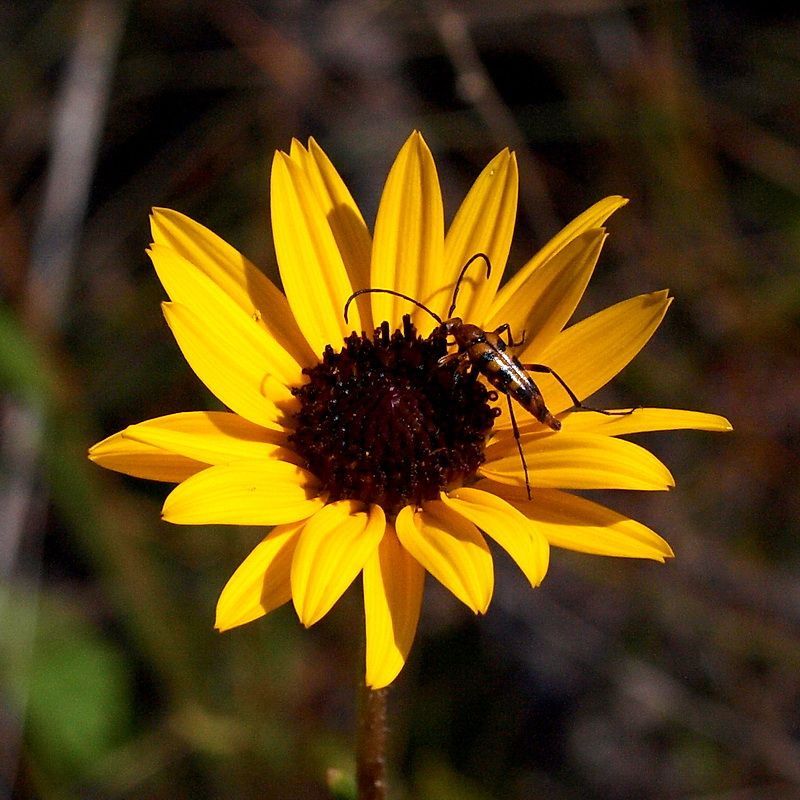FNPS Plant Database
Rudbeckia hirta
Nomenclature
Common Name:
Synonym(s):
Genus species:
Family:
Asteraceae
Plant Specifics
Form:
Size:
Life Span:
Long-lived perennial
Flower Color:
Fruit Color:
Phenology:
Noted For:
Landscaping
Recommended Uses:
Considerations:
Availability:
Propagation:
Light:
Moisture Tolerance:
Always Flooded---------------------------------Extremely Dry
□□□□□□□□□□□□□□□□□□■■■■■■■■■■■■■■■■■■■■■□□□
Somewhat moist, no flooding -to- Very long very dry periods
Salt Water Flooding Tolerance:
Unknown
Salt Spray/Salty Soil Tolerance:
Low/no tolerance of salty wind or direct salt spray
Soil or Other Substrate:
Sand
Soil pH:
Suitable to Grow In:
8A,8B,9A,9B,10A,10B

USDA zones are based on the average annual extreme minimum winter temperature.
Don't know your zone? Click here to search by zip code.
Ecology
Wildlife:
Attracts bumble bees, butterflies
Larval host for the silvery checkerspot, found only in extreme north Florida.
Seeds eaten by small birds such as finches.
Native Habitats:
Natural Range in Florida:
Visit the USF Libraries Atlas of Florida Plants
Comments:
Ethnobotany:
General Comments:
Citations:
EDIS. edis.ifas.ufl.edu/pdffiles/EP/EP34100.pdf https://edis.ifas.ufl.edu/fp512#:~:text=The many Rudbeckia species tolerate,planting close to the beach.
Haehle, Robert G. and Joan Brookwell. 1999. Native Florida Plants. Gulf Publishing Company. Houston, TX.
Huegel, Craig, N. 2012. Native wildflowers and other ground covers for Florida landscapes. University Press of Florida, Gainesville, FL.
Nelson, Gil. 2003. Florida's Best Landscape Plants. Association of Florida Native Nurseries.
Norcini, J. G. and J. H. Aldrich. 2007 (reviewed 2012). Performance of Native Florida Plants under North Florida Conditions.
Osorio, Rufino. 2001. A gardener's guide to Florida's native Plants. University Press of Florida, Gainesville, FL.
https://www.butterfliesandmoths.org/species/Chlosyne-nycteis
https://www.ncbi.nlm.nih.gov/pmc/articles/PMC4001241/
https://plantsforpollinators.weebly.com/black-eyed-susan.html
Osorio, Rufino. 2001. A gardener's guide to Florida's native Plants. University Press of Florida, Gainesville, FL.
Tras, Pamela. 2001. Gardening for Florida's butterflies. Great Outdoors Publishing, St. Petersburg, FL.
USDA: https://www.westernnativeseed.com/plant guides/rudhirpg.pdf
Wunderlin, R. P., B. F. Hansen, A. R. Franck, and F. B. Essig. 2021. Atlas of Florida Plants ( https://florida.plantatlas.usf.edu/ ). Institute for Systematic Botany, University of South Florida, Tampa.














